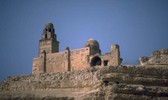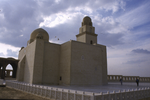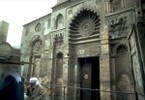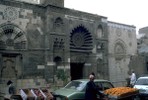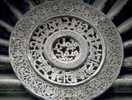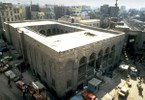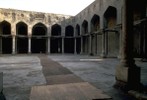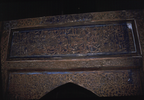Previous Lecture | Next Lecture
Concepts
The defenses of Cairo: Rebuilt between 1087 and 1092 by Badr al-Jamali with stronger brick walls and monumental stone gates. This may have been carried out by Syrian builders, for at least three gates -- Bab al-Nasr (Victory Gate) and Bab al-Futuh (Conquest Gate) in the north and Bab Zuwayla (Gate of Zuwayla) in the south -- are said to have been built by three Armenian brothers from al-Ruha (Edessa), and stylistically they do resemble contemporary north Syrian architecture.
Badr al-Jamali: A general who brought his army from Syria in 1074 in response to a plea by the caliph al-Mustansir to restore order in Egypt. He soon consolidated his control over the entire country and became the vizier as well as army commander (amir al-juyush), leaving the caliph as a mere religious figurehead.
The Mashhad al-Juyyushi: Built by Badr in 1085 and identified as a mashhad, though its real function is puzzling. The current interpretation is that Badr built it as a memorial to commemorate his victories and rise to power.
The Mashhad of Umm Kulthum: (1122) A memorial for Umm Kulthum, a popular saint and descendant of `Ali.
Al-Aqmar Mosque: A small mosque built in 1125 north of the Eastern palace and celebrated for its unusual decorated façade and its plan which accommodate both the qibla orientation and the streets pattern.
The Mashhad of Sayyida Ruqayya: (1133) A memorial for Ruqayya, a popular saint and descendant of `Ali.
The Mausoleum of Yahya al-Shabih: (ca. 1150) A mausoleum built around the cenotaph of Yahaya, called al-shabih (the look-alike) because he resembled the Prophet, and other descendants of `Ali, all buried there in the 870s-80s.
Al-Salih Tala'i` Mosque: Built south of the walls of al-Qahira in 1160 by the vizier al-Salih Tala'i` and intended as a mashhad for the head of Husayn, the son of `Ali and most venerated martyr in Shiism. It was turned into a mosque when the caliph decided that the head of Husayn should be buried inside his palace.
Architectural terms:
Qubba: Literally "dome", but the word often signified the mausoleum of an amir or a pious man, which was usually, but not always, a cubical structure covered with a dome.
Mashhad: A complex term that means either a memorial for a shahid (witness of the greatness of God, but later exclusively meaning martyr) or a memorial for a true vision, which mostly involves the Prophet or members of his family.
Muqarnas: One of the most distinctive architectural elements, called usually the stalacite pendentives or honeycomb vaults. Muqarnas units appear in domes' transitional zones, in cornices and friezes, in conches above entrances, and on friezes supporting balconies of minarets. The origin and date of first appearance of muqarnas are not clear. It is used for decorative purposes and several symbolic meanings have been proposed for it.
Monuments


